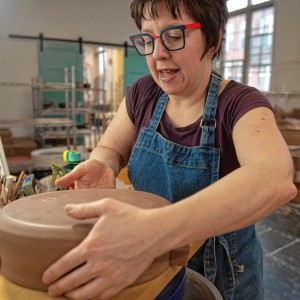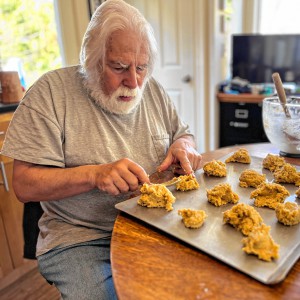Extraordinary Paintings of Ordinary Gals: The pioneering work of Isabel Bishop
| Published: 01-10-2019 4:49 PM |
In the early 1900s, few young American women were allowed to go about unchaperoned. Fewer still would likely have been permitted to attend college on their own, almost 500 miles from home, and at the tender age of 16.
But the painter and printmaker Isabel Bishop didn’t let those mores define her. It didn’t hurt that her mother was part of the women’s suffrage movement, or that her parents had artistic and academic interests and had enrolled her in art classes in Detroit when she was 12. By 1918, when she was just 16, Bishop was studying art in New York City — and she would go on to use New York as her base in a career in which she made a name for herself as a chronicler of ordinary people, especially working women.
In the pantheon of 20th-century American women artists, Bishop (1902-1988) doesn’t have the name recognition of U.S. contemporaries such as Georgia O’Keefe or Lee Krasner. But an exhibit at the D’Amour Museum of Fine Arts in Springfield is making the case for her importance, showcasing her innovative paintings that blended classical references and techniques with modernist subjects and tone, as well as drawings and prints in which she recorded her interest in movement and women’s relationships.
And though the exhibit, “Isabel Bishop’s Working Women: Defying Convention,” is focused on her portraits of women, the show also stresses that Bishop never wanted her work to be defined by her gender. As she once said, “I didn’t want to be a woman artist, I just wanted to be an artist.”
What she did want to do was create portraits of the growing numbers of women she saw in lower Manhattan who entered the work force in the 1920s, 1930s and 1940s — part of what came to be known as the “New Women” of that era, who in asserting their independence, taking jobs outside the home and becoming more visible in public were creating a new understanding of femininity.
Bishop’s approach represented a significant departure from the history of painting, exhibit organizers say, as she wasn’t interested in depicting women within the traditional parameters: as mothers, sexual figures or wealthy matriarchs.
Maggie North, acting curator of art for Springfield Museums, says that though Bishop never specifically presented herself as a feminist, her life as an artist — she kept her name after marrying and painted into her 80s — and her choice of subject matter embodied a feminist perspective.
“I think she was incredibly progressive,” said North. “She was certainly very aware of the gender divide. She kept painting after she was married, which was unusual for a lot of female artists at that time. But I also think she sort of chose to lead by example” rather than making overt statements about feminism.
Article continues after...
Yesterday's Most Read Articles
 South Hadley’s Lauren Marjanski signs National Letter of Intent to play soccer at Siena College
South Hadley’s Lauren Marjanski signs National Letter of Intent to play soccer at Siena College
 LightHouse Holyoke to buy Gateway City Arts, expand offerings and enrollment at alternative school
LightHouse Holyoke to buy Gateway City Arts, expand offerings and enrollment at alternative school
 Treehouse, Big Brothers Big Sisters turn race schedule snafu into positive
Treehouse, Big Brothers Big Sisters turn race schedule snafu into positive
 South Hadley man fatally shot in attempted robbery
South Hadley man fatally shot in attempted robbery
 Granby man admits guilt, gets 2½ years in vehicular homicide
Granby man admits guilt, gets 2½ years in vehicular homicide
 Area briefs: Transhealth to celebrate 3 year; Holyoke to plant tree at museum; Documentary film about reparations focus of Unitarian talk
Area briefs: Transhealth to celebrate 3 year; Holyoke to plant tree at museum; Documentary film about reparations focus of Unitarian talk
Bishop began gaining wider attention in the early 1930s, when she had her first solo exhibition in New York and sold a painting, “Two Girls,” to the Metropolitan Museum of Art. She specialized in showing women who worked in offices and shops in lower Manhattan out on their lunch breaks, whether on a park bench or at the counter of a diner, or hanging onto overhead subway straps, or walking together on the sidewalk. They were intimate portraits, where these women, freed from the constraints of the workplace, could laugh, chat freely and share the day’s news — and do so in a part of the city that had typically been defined by men.
Julia Courtney, guest curator of the Bishop exhibit, says Bishop was “considered a pioneer in multiple-figure compositions,” and that she employed a complicated layering process for her paintings that included gesso (a plaster-chalk binding agent) and underlying layers of paint, charcoal and ink that would create a background grid for reference; to that she’d add egg tempera and oil paint.
This was only done after she’d typically produced multiple preparatory studies such as drawings and prints; she also used enormous photographic enlargements of some prints as a compositional aid. Some of her paintings could take a year to finish, Courtney notes, and even then the artist might leave some of that work deliberately incomplete, giving the paintings the quality of faded frescos or mosaics.
“Bishop made no attempt to show all aspects of a scene or to finish a painting in a traditional manner because she believed that hints of incompleteness helped to suggest the passage of time,” Courtney writes in an accompanying catalog to the exhibit.
“She was fascinated by the old masters, painters like Peter Paul Rubens [1577-1640], but she was applying those techniques to these very modern subjects and themes,” Courtney said in a recent phone interview. “It makes for a wonderful combination.”
You can see some of those ideas and style in “At the Noon Hour,” a noted work from that era, now owned by Springfield Museums. Composed of tempera and graphite on board, the 1935 painting profiles two youngish women, nicely but not elaborately dressed, standing and talking with arms linked on a street in front of a now-vanished German restaurant in Manhattan. Like much of Bishop’s work, the grid-like background, in pale, earth colors, and the textured layers give the painting a sense of movement.
Although the exhibit is focused on Bishop’s portraits of women, she also drew and painted men, such as the unemployed men she would see in Union Square, near her studio, during the Great Depression. Courtney says these portraits showed considerable empathy to men who were routinely referred to at the time as “hobos.”
But in “Double Date Delayed No. 1,” an oil on masonite board painting from 1948, Bishop shows two women and a man, seated on what appears to be a park bench, as the women chat; the man, seated between them, looks awkward, not part of the conversation. To the artist, the women are the more interesting subjects.
Though the Springfield exhibit draws material from a number of sources, including the Smith College Museum of Art and the Mount Holyoke Art Museum, the show is built in large part on collected works — paintings, drawings, ink washes, engravings and etchings — by Bishop that were inherited by two of her granddaughters, one of whom lives in the Valley. Many of these pieces have never been exhibited before.
Courtney, curator emeritus of art at Springfield Museums, says staff first learned of these collections some years back from Richard Scorpio, a professor of art and art history at Amherst College, who she says “has a connection with Heather Haskel,” the vice president and director of art museums for the Springfield complex.
In 2016, Courtney recalls, one of the granddaughters — neither wants to be publicly identified — brought in her Bishop portfolio to have museum staff assess its general condition and advise her on methods of conserving it. Courtney, who today is the curator of collections for the Art Complex Museum in Duxbury (south of Boston), said she was immediately taken by what she was seeing.
“I was astounded by what [the granddaugher] had,” she said in a recent phone call from Duxbury. “Both the number of items and the depth of the collection were amazing.”
Particularly intriguing to her were the many preparatory pieces — initial sketches and drawings, prints and engravings — that Bishop had made as compositional building blocks for her paintings. “You could see this whole history of how she’d constructed her paintings in a very careful, meticulous way,” said Courtney.
Courtney and other staff cataloged that collection, and they did the same for the Bishop pieces from her second granddaughter, who lives in Connecticut, after she had them shipped to the museum for evaluation. Soon enough, museum staff and both granddaughters agreed they should put together a show on Bishop’s work, with some 100 pieces culled from over 200 works from the granddaughters’ combined collections.
“I was so thankful I got to work on this exhibit,” says Courtney, who left Springfield Museums in 2017 to work as an independent curator. “I had seen some of [Bishop’s] work in different places over the years, but this was the first time I had an opportunity to see all this other work up close.”
The exhibit relates some of Bishop’s history. She enrolled first in the New York School of Applied Design for Women to study graphic arts, then went to the Art Students League of New York, where she studied with the painter Kenneth Hayes Miller, an influential teacher of the era; she was also influenced by artists such as Reginald Marsh and the modernist Robert Henri. She became part of what was known as the Fourteenth Street School of artists, New York painters who focused on realistically portraying everyday life. In 1936, Bishop became the first full-time female instructor at the Art Students League. And in 1979, U.S. President Jimmy Carter presented her with the Outstanding Achievement in the Arts award.
Bishop also benefited from men in her life who took her artwork seriously. One of her uncles helped fund her early art studies, and her husband, the neurologist Dr. Harold G. Wolff, whom she married in 1932, did not insist she give up her work and stay at home — certainly an unusual attitude in that era, Courtney notes.
She kept her studio near Union Square for decades, which meant she was able to chronicle the changing look and feel of lower Manhattan’s streets. The Springfield exhibit showcases a number of her drawings, prints and paintings from the 1970s and 1980s, for instance, where long-haired young women in jeans and T-shirts, or short skirts and blouses — New York University students — make their way down the sidewalks or grab lunch at a cafe.
Courtney notes that Bishop’s studio at one point had a very hip downstairs neighbor, too: Andy Warhol’s Factory. In her catalog, she also recounts how one of Bishop’s granddaughters, who went through a punk rock phase as a teenager that entailed “crazy hair and even crazier makeup,” got an enthusiastic endorsement from her elder: “Granny told me that she loved it all! She said it was wonderful and that she loved looking at me.”
And why wouldn’t she? By that point, Bishop had already long since helped establish an image of the modern working woman “and in so doing released her from all previous pre-determined roles,” writes Courtney. “Transformations happen slowly. Each generation is indebted to the previous one and artists like Isabel Bishop who pushed the boundaries of change.”
Steve Pfarrer can be reached at spfarrer@gazettenet.com.
“Isabel Bishop’s Working Women: Defying Convention” is on view at the D’Amour Museum of Fine Art in Springfield though May 26. For additional information, visit springfieldmuseums.org.

 Speaking of Nature: ‘Those sound like chickens’: Wood frogs and spring peepers are back — and loud as ever
Speaking of Nature: ‘Those sound like chickens’: Wood frogs and spring peepers are back — and loud as ever Hitting the ceramic circuit: Asparagus Valley Pottery Trail turns 20 years old, April 27-28
Hitting the ceramic circuit: Asparagus Valley Pottery Trail turns 20 years old, April 27-28 Best Bites: A familiar feast: The Passover Seder traditions and tastes my family holds dear
Best Bites: A familiar feast: The Passover Seder traditions and tastes my family holds dear Valley Bounty: Your soil will thank you: As garden season gets underway, Whately farm provides ‘black gold’ to many
Valley Bounty: Your soil will thank you: As garden season gets underway, Whately farm provides ‘black gold’ to many
